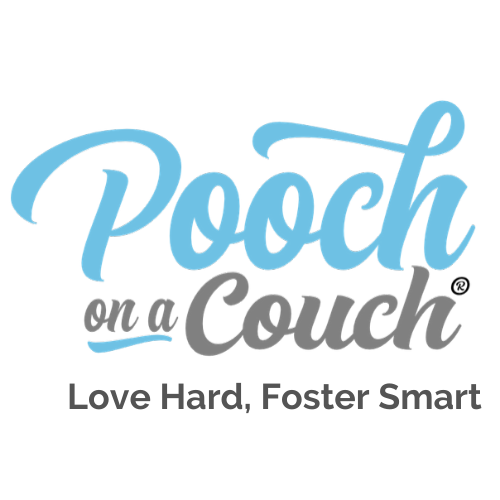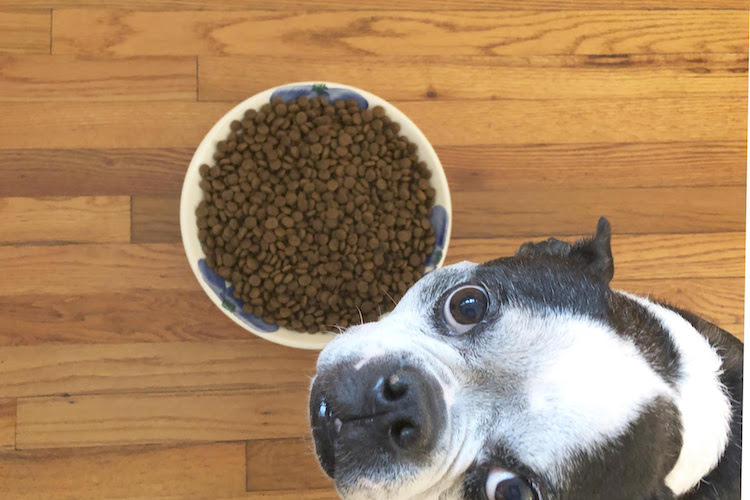Can I just say it??
Don’t free-feed a foster dog.
You can stop reading right there, change your flow and stop free-feeding foster dogs. If you are like, “what the what?” – let me explain why.
Free-Feeding and Foster Dogs Usually Don’t Mix
During my tenure as a foster coordinator, I managed several foster homes who were committed free-feeders for their personal pets. For them, the practice was a good choice. We discussed why it was problematic to free-feed a foster dog.
Almost all of the foster homes refused to stop the practice. Asking their personal pets to adapt to not having food available 24/7 was too hard. In nearly all households, problems arose that were directly related to the practice of free-feeding.
Free-Feeding A Foster Dog – The Cons Win
Here are some examples of how free-feeding a foster dog caused problems.
One of the foster dogs was not able to self-regulate her eating with a free-feeding plan and she became morbidly obese within a matter of a few short months, more than doubling her weight. The foster mom didn’t take our veterinarian’s intervention very well.
Another home struggled for months when her fearful, resource-guarding (and hoarding!) foster dog wouldn’t allow any of the other dogs to approach the communal feed bowl. Determined to make free-feeding work in her home, the foster mom tried a variety of ways to make peace around the food bowl, eventually with some success. As mentioned, it took months. She’d have had peace at the table, so to speak, within a matter of a week if she’d switched to feeding regular meals.
Some rescue agencies will not allow you to foster dogs if you free-feed. I allowed it on occasion, (the foster home was bringing a valuable skill to the table) and continued to educate as well as monitor the dog’s health and wellness in the home.
There are plenty of articles out there that talk about the pros and cons of free-feeding pets. This isn’t one of them. This post talks about why I don’t think you should free-feed a foster dog.
Better your relationship with your foster dog! Stop free-feeding.
The first responsibility you have to your foster dog is developing a relationship with that dog. No, I’m not talking about the “I’m the alpha of the household” non-relationship, I’m talking about building a relationship of safety, trust, and communication. You want your foster dog looking to you for everything that is good – food included.
When you make food available all day, every day, you give away the opportunity to use food when training or rewarding a dog for desirable behavior. You give away an opportunity to communicate with your dog.
2. Free-feeding hinders a foster dog’s house-training.
The second responsibility (and goal!) is to teach your foster dog that you want them to potty outside. If you free-feed a foster dog, you WILL have a harder time house-training that dog. When a dog’s gut is regulated – meaning, they` pee and poop with some predictability – you can anticipate when they need to go to the bathroom. I cannot predict when my dog needs to pee/poop if I don’t know when they are eating! Successful house-training protocols center around mealtime. (and play) Feed scheduled meals and your foster dog will be house-trained in no time.
Need help house training your foster dog? Read my post: How To House Train Your Foster Dog.
3. And how is your foster dog’s appetite? Free-feeding masks inappetence.
Dogs can’t tell us when they feel bad, they rely on us to notice changes in their behavior. Your foster dog is an unknown dog with unknown health issues. Unless your foster dog gets a full wellness visit (bloodwork, urinalysis, fecal testing) it may still be harboring an undisclosed illness. One of the most common “missed” illnesses in newly rescued foster dogs is the urinary tract infection. (UTI) A dog with a UTI feels like crap.
So does an upper respiratory infection. Most of our shelter rescue dogs have it.
One way dogs tell us they feel bad is to show us by not eating. Sick dogs often have a decreased appetite. Are you going to watch that food bowl 24/7 and verify that adequate nutrition was consumed by your foster dog? I can’t do that! Can you? Dr. Jennifer Coates of PetMD says it’s not easy to notice appetite changes when dogs are free-fed and writes, “the disease may have progressed past a critical point. I can’t overemphasize how important early diagnosis is to successful treatment.”
By feeding carefully portioned meals, should your foster dog become ill, you can seek early diagnosis and help your veterinarian by reporting, “Charlie hasn’t eaten any of his meals in two whole days.” or “Sissy is no longer finishing any of her meals. She’s been this way for several days.” Conversely, we can see our foster dog responding to treatments and feeling better when we see their appetite improve. This is so easy to see when we are feeding meals and nearly impossible to see when we free-feed a foster dog.
4. Free-feeding a foster dog will likely make them fat.
Don’t make your foster dog fat. Just don’t.
I don’t want to send a fat dog to an adopter. What does that say about my commitment to a dog’s health? “Oh, we’ve given him his shots and dewormed him, and neutered him for you, he’s healthy!” Fat as a tick and healthy?
Don’t help me save a life if you are gonna do that.
Science has spoken! Most dogs cannot appropriately self-regulate caloric intake. Most will overeat. Obese dogs are at risk of injury, arthritis, heart disease, and cancer. Why in the heck would you agree to save a life and then subject them to the development of a chronic condition?
Keep your foster dog at a healthy weight.
If you are not sure how much your foster dog should weigh, ask your veterinarian. They are more than happy to tell you a weight range, help you with portion/calorie control, and they’ll even let you come in to use their scales, free of charge. For a quick look into how to assess your foster dog’s body condition score, click here.
5. Free-feeding a foster dog may put them in a stressed state of mind.
Have you ever been to a neighborhood or church buffet? As a kid, I grew up attending church in the south. There were more potluck dinners there than I care to remember.
I also remember those folks who had no buffet manners. Even as a little kid, I was irritated by the pigginess of some people – taking all the crunchy toppings off the mac and cheese casserole, taking Miss Betty’s sausage bake and turning it upside-down in the casserole dish so they could get more sausage than rice, and taking the corner pieces of chocolate sheet cake before I could get to it. Hey. I like frosting.
I learned which ill-mannered human liked the same things I did, and I thought up plans to beat them to the table. I probably behaved rudely myself a time or two.
Free-feeding an anxious foster dog can cause more anxiety.
Food is an incredible motivator. For humans, and for dogs. Dogs who resource guard food can be quite motivated to protect their food. Other dogs may, belly full, remain worried about that huge bowl of food and never quite relax, humming along all day in a stressed state of mind. Will that other dog come and eat it all?
That can’t be good for their health, their sociability, or as important, their relationship with you.
Ease their minds. Switch to meals. You’ll see the anticipation (motivation) around mealtime, you can engage your dog in some training behaviors pre-meal, (sit for your food, please! Wait until I say OK!) they will eat, go outside and potty, and have a worry-free romp in the yard.
6. Never free-feed a foster dog that is severely emaciated.
You can kill them.
If you have a foster dog that is severely emaciated, you must talk with your veterinarian about a refeeding program. If you want to read more about how to help really thin foster dogs, check out my post, Saving An Emaciated Dog.
Just So Ya Know, Free-Feeding is Gross
Free-feeding can be really unsanitary! Bugs, bacteria, and yep – even wildlife can invade that ever-flowing bowl of food. Ew.
How To Shift Away From a Free-Feeding Schedule to a Time-Limited Schedule
- Decide when you are going to feed. One meal a day? Experts recommend two meals a day, but if one is all you can do, do that.
- Decide how much you are going to feed. Start by looking at the guidelines on your bag of dog food. Divide the daily amount by the number of meals you will feed.
- At mealtime, portion out the amount you’ve calculated and put the bowl down. leave it down for 20 minutes, then pick it back up and don’t feed again until the next meal. Is there uneaten food in the bowl?? It’s OK! No worries. Stay strong!! Your dog will be fine. It will take 2-3 days for most dogs to fully adjust to the new feeding schedule.
For a more comprehensive article on shifting from free-feeding to a time-limited schedule, check out this article:
Stop Free-Feeding: How To Feed Your Dog Regular Meals

My Veterinarian Told Me To Free-Feed My Foster Dog
Your veterinarian trumps me. There may be medical reasons why it is absolutely necessary for you to free-feed your foster dog. I have no argument against that.
Do make sure that you refer to the reasons I’ve listed and make management changes to your home as needed to support your foster dog’s total health.
Extra Credit Reading
5 Reasons To Not Free Feed Your Dog
Why Free-Feeding Is The Wrong Choice For Most Dogs
Feeding Times And Frequency For Your Dog
Popular Posts
- HOW TO CHOOSE A DOG RESCUE AGENCY
- ULTIMATE GUIDE TO FOSTERING: 10 SKILLS YOU NEED
- VOLUNTEER IF YOU CANNOT FOSTER





